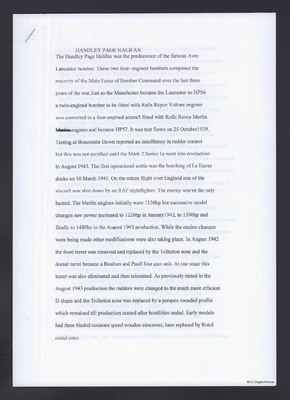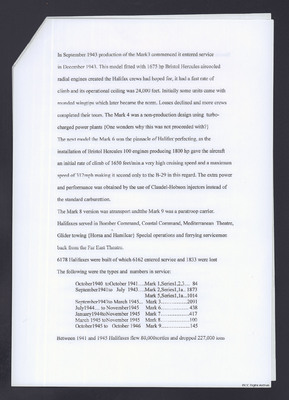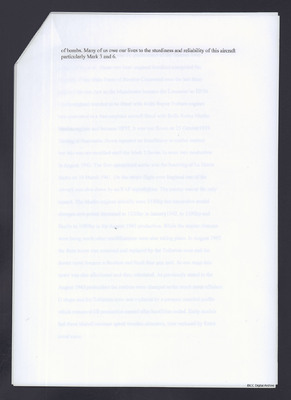Handley Page Halifax
Title
Handley Page Halifax
Description
Describes the introduction of Halifax into service with associated problems. Mentions first operations to Le Havre. Goes on to describe engine and gun turret upgrades as well as other modifications. Continues with introduction of Mk 3. and Mk 6 followed my Mk 8 and 9. Lists marks of Halifax and service dates as well as some operational statistics and notes roles it was used for.
Spatial Coverage
Language
Type
Format
Three page printed document
Publisher
Rights
This content is available under a CC BY-NC 4.0 International license (Creative Commons Attribution-NonCommercial 4.0). It has been published ‘as is’ and may contain inaccuracies or culturally inappropriate references that do not necessarily reflect the official policy or position of the University of Lincoln or the International Bomber Command Centre. For more information, visit https://creativecommons.org/licenses/by-nc/4.0/ and https://ibccdigitalarchive.lincoln.ac.uk/omeka/legal.
Contributor
Identifier
MThomasJH424515-180122-01
Transcription
HANDLEY PAGE HALIFAX
The Handley Page Halifax was the predecessor of the famous Avro Lancaster bomber. These two four-engined bombers composed the majority of the Main Force of Bomber Command over the last three years of the war. Just as the Manchester became the Lancaster so HP56 a twin-engined bomber to be fitted with Rolls Royce Vulture engines was converted to a four-engined aircraft fitted with Rolls Royce Merlin [deleted] Merlin [/deleted] engines and became HP57. It was test flown on 25 October 1939. Testing at Boscombe Down reported an insuffiency [sic] in rudder control but this was not rectified until the Mark 2, Series 1a went into production in August 1943. The first operational sortie was the bombing of Le Havre docks on 10 March 1941. On the return flight over England one of the aircraft was shot down by an RAF nightfighter. The enemy was’nt [sic] the only hazard. The Merlin engines initially were 1130hp but successive model changes saw power increased to 1220hp in January 1942, to 1390hp and finally to 1480hp in the August 1943 production. While the engine changes were being made other modifications were also taking place. In August 1942 the front turret was removed and replaced by the Tollerton nose and the dorsal turret became a Boulton and Paull four gun unit. At one stage this turret was also eliminated and then reinstated. As previously stated in the August 1943 production the rudders were changed to the much more efficient D shape and the Tollerton nose was replaced by a perspex rounded profile which remained till production ceased after hostilities ended. Early models had three bladed constant speed wooden airscrews, later replaced by Rotol metal ones.
[page break]
In September 1943 production of the Mark3 commenced it entered service in December 1943. This model fitted with 1675 hp Bristol Hercules aircooled radial engines created the Halifax crews had hoped for, it had a fast rate of climb and its operational ceiling was 24,000 feet. Initially some units came with rounded wingtips which later became the norm. Losses declined and more crews completed their tours. The Mark 4 was a non-production design using turbo-charged power plants {One wonders why this was not proceeded with?}
The next model the Mark 6 was the pinnacle of Halifax perfecting, as the installation of Bristol Hercules 100 engines producing 1800 hp gave the aircraft an initial rate of climb of 1650 feet/min. a very high cruising speed and a maximum speed of 312mph making it second only to the B-29 in this regard. The extra power and performance was obtained by the use of Claudel-Hobson injectors instead of the standard carburettion [sic].
The Mark 8 version was a transport andtthe[sic] Mark 9 was a paratroop carrier. Halifaxes served in Bomber Command, Coastal Command, Mediterranean Theatre, Glider towing {Horsa and Hamilcar} Special operations and ferrying servicemen back from the Far East Theatre.
6178 Halifaxes were built of which 6162 entered service and 1833 were lost
The following were the types and numbers in service:
October 1940 to October 1941 .... Mark 1, Series 1, 2, 3...84
September 1941 to July 1943 .... Mark 2, Series 1, 1a.. 1873
Mark 5, Series 1, 1a... 1014
September 1943 to March 1945 ... Mark 3 ............... 2091
July 1944 ... to November 1945 Mark 6 ................ 438
January 1944 to November 1945 Mark 7 ................. 417
March 1945 to November 1945 Mark 8 ................. 100
October 1945 to October 1946 Mark 9 ................. 145
Between 1941 and 1945 Halifaxes flew 80,000 sorties and dropped 227,000 tons
[page break]
of bombs. Many of us owe our lives to the sturdiness and reliability of this aircraft particularly Mark 3 and 6.
The Handley Page Halifax was the predecessor of the famous Avro Lancaster bomber. These two four-engined bombers composed the majority of the Main Force of Bomber Command over the last three years of the war. Just as the Manchester became the Lancaster so HP56 a twin-engined bomber to be fitted with Rolls Royce Vulture engines was converted to a four-engined aircraft fitted with Rolls Royce Merlin [deleted] Merlin [/deleted] engines and became HP57. It was test flown on 25 October 1939. Testing at Boscombe Down reported an insuffiency [sic] in rudder control but this was not rectified until the Mark 2, Series 1a went into production in August 1943. The first operational sortie was the bombing of Le Havre docks on 10 March 1941. On the return flight over England one of the aircraft was shot down by an RAF nightfighter. The enemy was’nt [sic] the only hazard. The Merlin engines initially were 1130hp but successive model changes saw power increased to 1220hp in January 1942, to 1390hp and finally to 1480hp in the August 1943 production. While the engine changes were being made other modifications were also taking place. In August 1942 the front turret was removed and replaced by the Tollerton nose and the dorsal turret became a Boulton and Paull four gun unit. At one stage this turret was also eliminated and then reinstated. As previously stated in the August 1943 production the rudders were changed to the much more efficient D shape and the Tollerton nose was replaced by a perspex rounded profile which remained till production ceased after hostilities ended. Early models had three bladed constant speed wooden airscrews, later replaced by Rotol metal ones.
[page break]
In September 1943 production of the Mark3 commenced it entered service in December 1943. This model fitted with 1675 hp Bristol Hercules aircooled radial engines created the Halifax crews had hoped for, it had a fast rate of climb and its operational ceiling was 24,000 feet. Initially some units came with rounded wingtips which later became the norm. Losses declined and more crews completed their tours. The Mark 4 was a non-production design using turbo-charged power plants {One wonders why this was not proceeded with?}
The next model the Mark 6 was the pinnacle of Halifax perfecting, as the installation of Bristol Hercules 100 engines producing 1800 hp gave the aircraft an initial rate of climb of 1650 feet/min. a very high cruising speed and a maximum speed of 312mph making it second only to the B-29 in this regard. The extra power and performance was obtained by the use of Claudel-Hobson injectors instead of the standard carburettion [sic].
The Mark 8 version was a transport andtthe[sic] Mark 9 was a paratroop carrier. Halifaxes served in Bomber Command, Coastal Command, Mediterranean Theatre, Glider towing {Horsa and Hamilcar} Special operations and ferrying servicemen back from the Far East Theatre.
6178 Halifaxes were built of which 6162 entered service and 1833 were lost
The following were the types and numbers in service:
October 1940 to October 1941 .... Mark 1, Series 1, 2, 3...84
September 1941 to July 1943 .... Mark 2, Series 1, 1a.. 1873
Mark 5, Series 1, 1a... 1014
September 1943 to March 1945 ... Mark 3 ............... 2091
July 1944 ... to November 1945 Mark 6 ................ 438
January 1944 to November 1945 Mark 7 ................. 417
March 1945 to November 1945 Mark 8 ................. 100
October 1945 to October 1946 Mark 9 ................. 145
Between 1941 and 1945 Halifaxes flew 80,000 sorties and dropped 227,000 tons
[page break]
of bombs. Many of us owe our lives to the sturdiness and reliability of this aircraft particularly Mark 3 and 6.
Collection
Citation
“Handley Page Halifax,” IBCC Digital Archive, accessed July 27, 2024, https://ibccdigitalarchive.lincoln.ac.uk/omeka/collections/document/34240.
Item Relations
This item has no relations.



